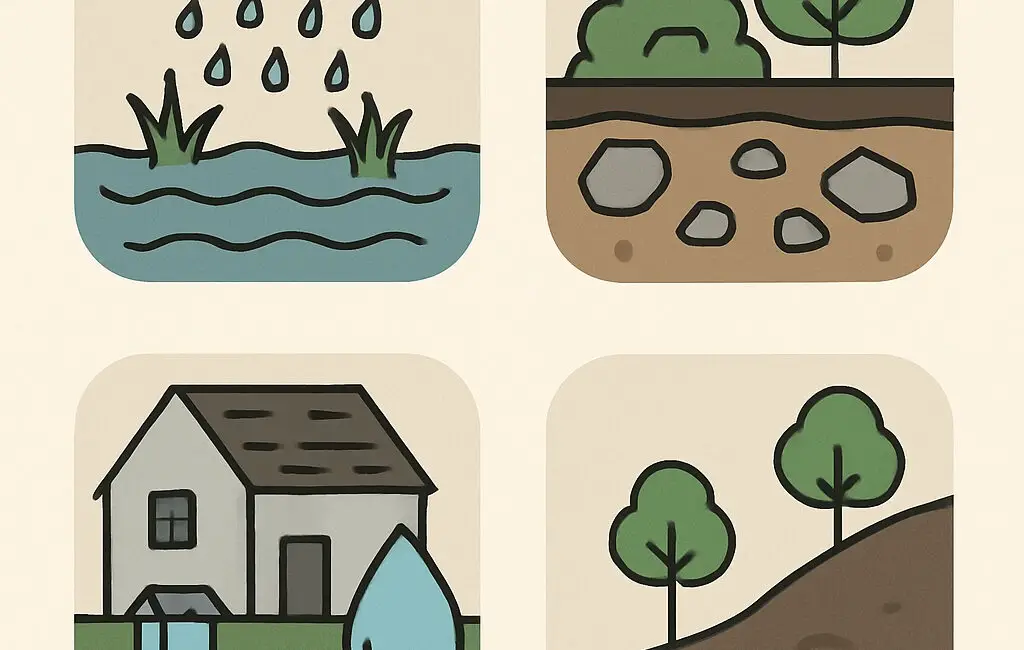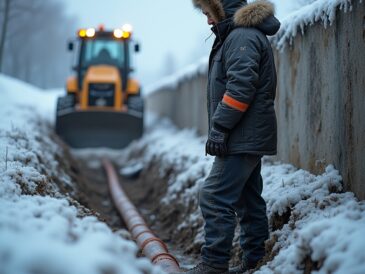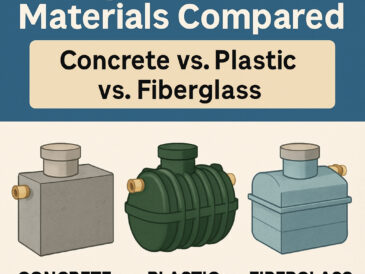When it comes to septic systems, not all properties are created equal. While conventional septic systems work wonderfully for many homes, certain property characteristics can turn your dream installation into a nightmare scenario. Understanding whether your property is not suitable for conventional septic systems before you start digging can save you thousands of dollars, countless headaches, and potential environmental disasters.
Conventional septic systems rely on gravity, proper soil conditions, and adequate space to treat wastewater effectively. When these fundamental requirements aren’t met, you’re looking at system failures, environmental contamination, and expensive repairs down the road. Recognizing the warning signs early allows you to explore alternative solutions or adjust your property plans accordingly.
Let’s dive into the seven key indicators that your property might not be suitable for a conventional septic system installation.
Sign 1: High Water Table
Your septic system’s drain field needs breathing room below ground, and a high water table is like having an unwelcome neighbor who stands too close. When groundwater levels sit within three feet of your proposed drain field, you’ve got a recipe for disaster.
A conventional septic system works by allowing liquid effluent to percolate through soil layers, where beneficial bacteria filter out harmful pathogens before the water reaches groundwater. When the water table is high, this natural filtration process gets short-circuited. Instead of proper treatment, you end up with contaminated groundwater and a system that backs up faster than traffic on a Friday afternoon.
High water tables also create hydraulic pressure that can push groundwater into your septic components, diluting the treatment process and potentially causing sewage to surface in your yard. If you notice standing water in your yard during wet seasons or if neighboring properties have wells with shallow water levels, your water table might be too high for conventional septic installation.
“A high water table is one of the most common reasons we see septic system failures. The system simply can’t function properly when it’s fighting against groundwater pressure. We always recommend a thorough hydrogeological assessment before installation.”
– Sarah Mitchell, Licensed Hydrogeologist
Sign 2: Poor Soil Composition
Soil is the unsung hero of septic systems, acting as nature’s filter to clean wastewater before it reaches groundwater. However, not all soils are up for the job. Your soil needs to hit the Goldilocks zone – not too permeable, not too restrictive, but just right.
Clay soils are the villain in this story. While clay might be great for pottery, it’s terrible for septic systems because it’s nearly impermeable. Water moves through clay at a snail’s pace, causing effluent to back up and potentially surface in your yard. On the flip side, sandy or gravelly soils can be too permeable, allowing untreated wastewater to reach groundwater too quickly.
Rock-heavy soils present their own challenges, making excavation difficult and expensive while preventing proper effluent distribution. Shallow soils with bedrock close to the surface don’t provide adequate treatment depth.
A professional percolation test (perc test) is essential for determining soil suitability. This test measures how quickly water moves through soil, with ideal rates typically falling between 1-30 minutes per inch of drop. If your soil fails the perc test, conventional septic installation becomes problematic.
Sign 3: Small or Irregular Lot Size
Conventional septic systems are space hogs, requiring specific setback distances from wells, property lines, buildings, and other features. If your lot is smaller than an acre or has an irregular shape, you might find yourself playing septic Tetris with no winning combinations.
Most jurisdictions require minimum distances of 100 feet from wells, 50 feet from property lines, 20 feet from buildings, and 10 feet from driveways. The drain field itself typically needs 1,500 to 4,000 square feet, depending on your home’s size and local soil conditions.
Narrow lots are particularly challenging because they limit your options for drain field placement. If your lot is less than 150 feet wide, you might struggle to meet setback requirements while maintaining adequate system size. Corner lots often face additional challenges due to multiple street frontages and utility easements.
Don’t forget about reserve areas – many jurisdictions require designating space for a replacement drain field equal to 100% of your primary system size. This requirement can double your space needs overnight.
Sign 4: Steep or Sloped Terrain
While a gently sloping lot can actually benefit septic installation by promoting drainage, steep slopes create serious challenges for conventional systems. Slopes greater than 20% make your property unsuitable for standard gravity-fed septic systems.
Steep terrain affects effluent distribution, causing wastewater to flow downhill too quickly without proper treatment. This rapid movement can lead to surfacing effluent, soil erosion, and system failure. Additionally, steep slopes make excavation dangerous and expensive, often requiring specialized equipment and engineering solutions.
Gravity works against you on steep slopes, potentially causing uneven distribution in the drain field. Some areas may become oversaturated while others remain dry, reducing overall system efficiency and lifespan.
If your property has significant elevation changes, you might need alternative systems like pump-assisted or mound systems, which come with higher installation and maintenance costs.
“Slope is often overlooked until it’s too late. We’ve seen homeowners spend thousands trying to make conventional systems work on steep terrain when alternative systems would have been more cost-effective from the start.”
– Mike Rodriguez, Master Septic System Installer
Sign 5: Proximity to Water Bodies
If your property borders a lake, river, stream, or wetland, you’re dealing with strict environmental regulations that can make conventional septic installation challenging or impossible. These buffer zones exist to protect water quality and aquatic ecosystems from septic system contamination.
Most jurisdictions require setbacks of 75-100 feet from surface water bodies, but some environmentally sensitive areas demand distances of 200 feet or more. Wetlands often require even larger buffers, sometimes extending 100-300 feet depending on local regulations.
These restrictions aren’t just bureaucratic red tape – they’re essential for environmental protection. Septic system failures near water bodies can cause algae blooms, fish kills, and contamination of drinking water sources. The closer your system to water, the higher the risk of environmental damage if something goes wrong.
Seasonal water bodies and intermittent streams also count toward setback requirements, even if they’re dry most of the year. Don’t assume that dry creek bed won’t affect your septic placement – it probably will.
Sign 6: Existing Infrastructure and Obstacles
Your property might look perfect on paper, but existing infrastructure can turn septic installation into an expensive obstacle course. Buildings, driveways, patios, swimming pools, and large trees can all interfere with proper system placement.
Underground utilities are particularly problematic. Gas lines, electric cables, water mains, and telecommunications infrastructure can severely limit your options for drain field placement. Moving utilities is possible but expensive, often costing more than alternative septic systems.
Mature trees present a double challenge. Not only do their root systems potentially interfere with septic components, but many homeowners are reluctant to remove established landscaping. Tree roots can clog pipes, damage tanks, and disrupt drain field function over time.
Paved areas like driveways and patios prevent access for installation and future maintenance. While it’s possible to install systems under paved areas, it significantly increases costs and complicates future repairs or pumping.
Sign 7: Frequent Flooding or Standing Water
If your property is located in a flood-prone area or experiences regular standing water, conventional septic systems become problematic. Flooding can overwhelm septic systems, causing backups, contamination, and expensive damage.
Areas within the 100-year floodplain face additional regulatory challenges, with many jurisdictions requiring special permits or prohibiting septic installation entirely. Even if installation is allowed, flood insurance and long-term maintenance costs can be substantial.
Standing water indicates poor drainage, which is fundamental to septic system function. If water regularly pools in your yard after rain, your soil likely won’t handle septic effluent effectively. This poor drainage can lead to surfacing sewage, system backups, and health hazards.
Seasonal flooding is particularly challenging because it can overwhelm systems periodically, causing damage that might not be immediately apparent but reduces system lifespan and reliability.
“Properties with drainage issues are red flags for conventional septic systems. We always recommend addressing drainage problems first, or considering alternative systems designed for challenging conditions.”
– Jennifer Walsh, Environmental Engineer
What to Do If Your Property Is Not Suitable for Conventional Septic
Discovering that your property isn’t suitable for conventional septic doesn’t mean giving up on your development plans. Alternative septic systems can handle challenging conditions, though they typically cost more to install and maintain.
Mound systems work well for properties with high water tables or poor soil conditions by creating an elevated drain field with imported soil. Pump systems can handle steep slopes or challenging layouts by using pumps to distribute effluent. Advanced treatment units can reduce setback requirements in some jurisdictions.
Professional site evaluation is crucial for determining the best alternative system for your property. Licensed septic professionals can assess soil conditions, site constraints, and local regulations to recommend appropriate solutions.
Don’t attempt to modify your property to accommodate conventional septic without professional guidance. Improper modifications can create drainage problems, environmental damage, and regulatory violations that cost far more than alternative systems.
Moving Forward with Professional Guidance
Recognizing these warning signs early in your planning process can save significant time and money. A high water table, poor soil composition, limited lot size, steep slopes, proximity to water bodies, existing infrastructure obstacles, and drainage problems all indicate that your property is not suitable for conventional septic installation.
Professional evaluation is essential before making final decisions about septic system installation. Experienced septic professionals can identify site challenges, recommend appropriate alternatives, and help navigate local regulations to find workable solutions.
At Septic Service Center, we specialize in evaluating challenging properties and designing appropriate septic solutions. Our experienced team can assess your property’s unique conditions and recommend the most cost-effective approach for your septic needs. Contact us today for professional septic system evaluation and installation services that work with your property’s specific challenges.



